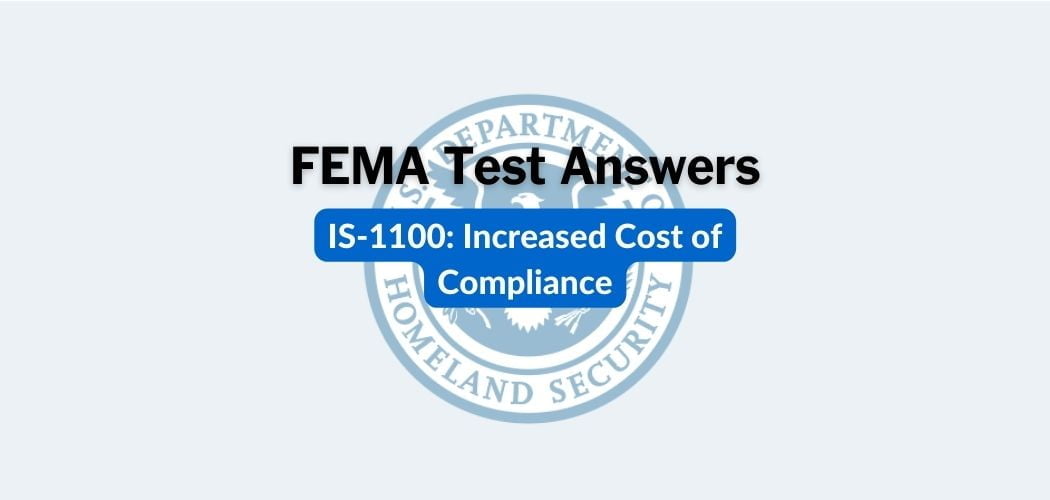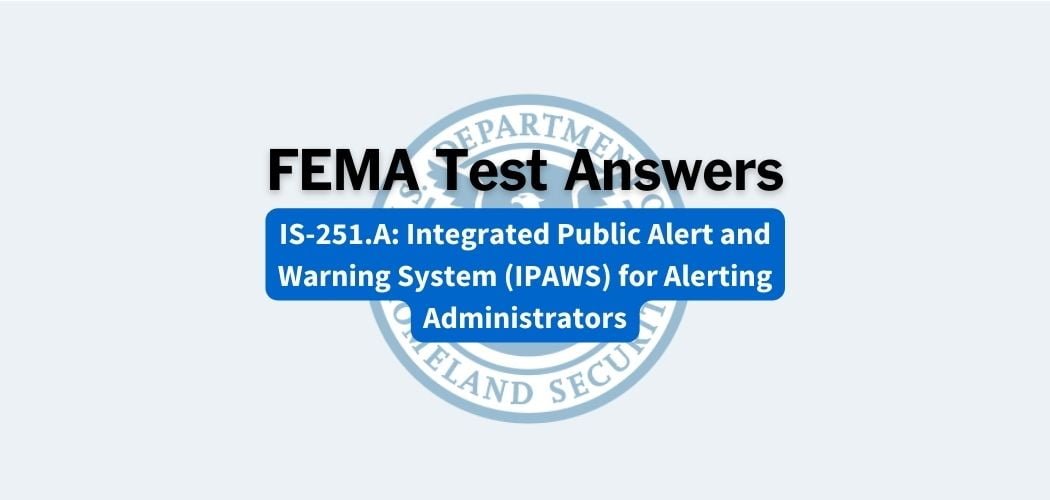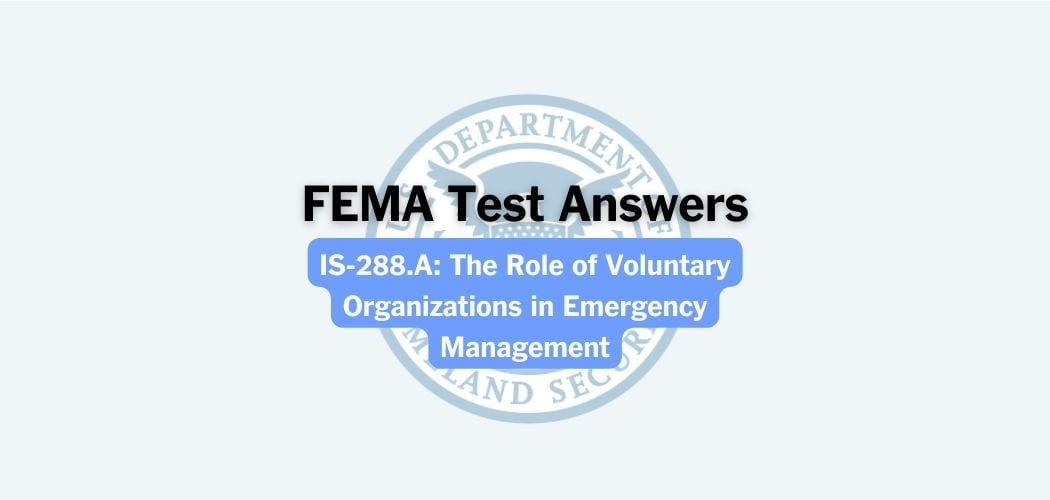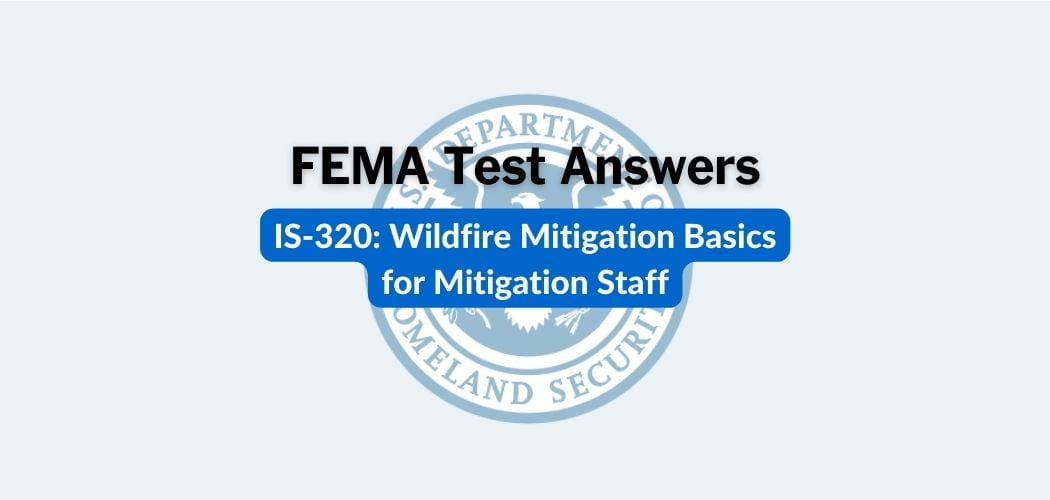Overview: FEMA IS-2900.A course was published on 7/11/2018. The National Disaster Recovery Framework (NDRF), developed in conformance with Presidential Policy Directive-8, outlines the basis for a national approach to disaster recovery.
Primary audience: FEMA IS-2900.A course is available to anyone to best meet the needs of individuals, families, communities, and states in their ongoing efforts to prevent, protect, mitigate, respond to and recover from any disaster event.
FEMA IS-2900.A test answers
Each time this test is loaded, you will receive a unique set of questions and answers. The test questions are scrambled to protect the integrity of the exam.
Question 1. Developing a strategic approach for coordinating Federal recovery support after a disaster strikes is a _______ responsibility of the _______.
A. Post-disaster; State Disaster Recovery Coordinator
B. Pre-disaster; Federal Disaster Recovery Coordinator
C. Post-disaster; Federal Disaster Recovery Coordinator
D. Pre-disaster; State Disaster Recovery Coordinator✅
Question 2. Maintaining adequate homeowner or renter insurance coverage is primarily a _______ responsibility of _______.
A. Post-disaster; local government
B. Pre-disaster; individuals and families
C. Post-disaster; individuals and families
D. Pre-disaster; local government✅
Question 3. The intended audience of the National Disaster Recovery Framework includes voluntary agencies.
A. TRUE✅
B. FALSE
Question 4. According to the recovery continuum, assessing the scope of recovery needs after a disaster occurs in which phase of activities?
A. Long-Term
B. Preparedness
C. Short-Term✅
D. Intermediate-Term
Question 5. Responsibilities and activities that determine resources and other support needed to address recovery needs after a disaster strikes are:
A. The exclusive responsibility of the Federal Government
B. Pre-disaster responsibilities and activities
C. Post-disaster responsibilities and activities✅
Question 6. Working with all groups of people affected by a disaster, and promoting inclusive and accessible outreach within the community, is an example of a _______ operational planning activity.
A. Pre-disaster
B. Post-disaster✅
C. During-disaster
Question 7. Which core capability contributes to recovery through the critical task of leading, coordinating, and driving the recovery process?
A. Health and Social Services
B. Public Information and Warning
C. Operational Coordination✅
D. Natural and Cultural Resources
Question 8. Establishing clear leadership, coordination, and decision-making structures at the local, state, and tribal levels ahead of a disaster is an example of a _______ operational planning activity.
A. Pre-disaster✅
B. Post-disaster
C. During-disaster
Question 9. The _______ specifically defines each of the core capabilities and the critical tasks required to deliver each capability.
A. National Planning Guide
B. National Response Plan
C. National Incident Management System
D. National Preparedness Goal✅
Question 10. Previous disaster recovery efforts highlighted the need for:
A. The State government to lead recovery for all the jurisdictions within the State itself
B. Focused recovery leadership at every level of government✅
C. Local recovery goals to be determined and managed by the Federal Government
D. The importance of preparing exclusively for manmade disasters
Question 11. One of the NDRF guiding principles states that recovery does not apply exclusively to the built environment, but also to the _______ of individuals who have been through traumatic events.
A. Financial support and sustainment
B. Homes and automobiles
C. Psychological and emotional recovery✅
D. Businesses and business equipment
Question 12. Following are two characteristics of which one of the four factors for a successful recovery: Defining roles and responsibilities for all stakeholders and examining recovery alternatives, addressing conflicts, and making informed and timely decisions?
A. Resilient rebuilding
B. Effective decision-making and coordination✅
C. Effective financial and program management
D. “Proactive Community Engagement, and Public Awareness”
Question 13. The Federal Government has six Recovery Support Functions. State X has 12 recovery support function equivalents. If all the Federal Recovery Support Functions are activated to Support State X after a disaster, what happens?
A. The Federal Recovery Support Function structure is flexible. It will adapt to State X’s recovery structure.
B. The Federal Government creates new recovery support functions.
C. No Federal recovery support is offered because the Stafford Act prohibits local, state, and tribal governments from adopting recovery structures not described in the NDRF.
D. State X’s recovery structure must align with the Federal structure to allow for maximum Federal recovery support.✅
Question 14. The _______ builds and maintains Federal interagency relationships and support for recovery during disaster and non-disaster times.
A. Federal Disaster Recovery Coordinator✅
B. Local Disaster Recovery Manager
C. State Disaster Recovery Coordinator
D. Tribal Disaster Recovery Coordinator
Question 15. The Federal Government has six recovery support functions. This is not necessarily the way local, state, or tribal governments may organize their recovery. If the local, state or tribal government recovery structures do not exactly align with the Federal structure, what happens?
A. The Federal Recovery Support Function structure is flexible. It adapts to the structure of the community, state, or tribe being supported.
B. The Federal Government creates new recovery support functions.
C. No Federal recovery support is offered because the Stafford Act prohibits local, state, and tribal governments from adopting recovery structures not described in the NDRF.✅
D. Local, State, and tribal recovery structures must align with the Federal structure to allow for maximum Federal recovery support.
Question 16. Providing a link between Federal resource providers and local governments to ensure that recovery needs are addressed after a disaster is primarily a _______ responsibility of _______.
A. Post-disaster; State government✅
B. Pre-disaster; individuals and families
C. Post-disaster; individuals and families
D. Pre-disaster; State government
Question 17. Which of the following is NOT one of the core capabilities that span across all five mission areas?
A. Public Information and Warning
B. Health and Social Services✅
C. Planning
D. Operational Coordination
Question 18. Providing leadership, coordination, and oversight for a particular Recovery Support Function is the responsibility of:
A. FEMA
B. The Recovery Support Function’s Coordinating Agency✅
C. The Recovery Support Function’s Supporting Organizations
Question 19. Coordinating the development, training, and exercise of State recovery plans to increase the level of preparedness is a _______ responsibility of the _______.
A. Post-disaster; State Disaster Recovery Coordinator
B. Pre-disaster; Federal Disaster Recovery Coordinator
C. Post-disaster; Federal Disaster Recovery Coordinator
D. Pre-disaster; State Disaster Recovery Coordinator✅
Question 20. The NDRF recommends that communities, states, and tribes appoint Local Disaster Recovery Managers (LDRMs) and State/Tribal Disaster Recovery Coordinators (SDRCs/TDRCs) to lead disaster recovery activities for their jurisdiction.
A. TRUE✅
B. FALSE



